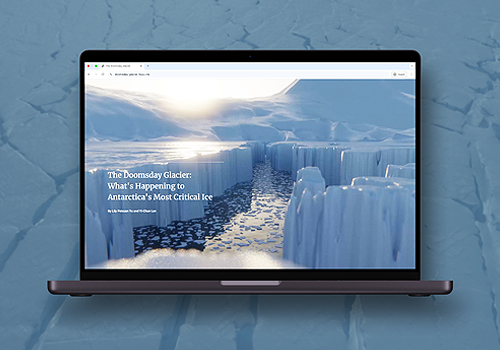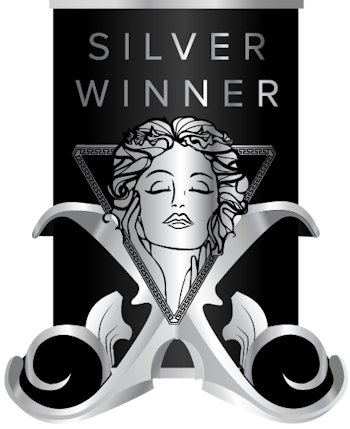
Interview
Peixuan Yu (Lily)
The Dallas Morning News, United States
Peixuan Yu (Lily) is an Interactive News Developer at The Dallas Morning News, blending computer science and media arts to create immersive storytelling. She crafts interactive experiences that inform, engage, and empower audiences across platforms.
1 Congratulations on your achievements in the MUSE Creative Awards! Could you start by introducing yourself or your agency? Can you also share a bit about your journey into your current industry?
My name is Peixuan Yu (Lily), and I’m currently working as an Interactive News Developer at The Dallas Morning News. With a background in computer science and media arts, I work at the intersection of design, technology, and storytelling—bridging these domains as a visual storyteller, experience designer, and creative developer. I hold a Master’s degree from NYU’s Interactive Telecommunications Program (ITP) at Tisch School of the Arts and a Bachelor’s degree in Computer Science and Interactive Media Arts from NYU Shanghai. My journey into the industry began with a deep curiosity about how emerging technologies could be used to tell stories that resonate. During my time at NYU, courses like Visual Journalism, taught by Yuliya Parshina-Kottas (then a Graphics Editor at The New York Times), and Designing for Impact, taught by Matt Parker at NYU Game Center, deepened my understanding of how design and technology can shape powerful narratives. Since then, I’ve been committed to crafting interactive storytelling experiences that inform, move, and empower audiences across platforms.
2 What inspired you to submit your work for this competition, and what does winning mean to you personally and professionally?
The MUSE Creative Awards’ emphasis on innovation and storytelling strongly aligns with the core of my practice. Submitting my work was a way to engage with a global creative community and receive recognition among peers who are also pushing boundaries in digital media and communication. Professionally, receiving this award enhances my international visibility and validates the originality of my work within a highly competitive industry. Personally, it affirms my continued commitment to designing impactful, story-driven experiences that live at the intersection of design, technology, and narrative.
3 Can you share the story behind your success? What inspired its creation, and what do you feel it represents in today’s industry?
“The Doomsday Glacier” began as an exhibition piece for NYU’s This Is Not A Drill open call showcase, hosted by the Elmer Holmes Bobst Library in 2023. I wanted to explore how interactive storytelling could communicate complex climate science to broader audiences in a compelling, emotionally resonant way. Inspired by a need to make scientific data more accessible, I expanded the original piece into a rich, web-based narrative experience. “Transcending Boundaries” was developed in collaboration with the United Nations, and centers around an interactive 3D globe experience that visualizes the UN’s global initiatives and organizational efforts across sectors such as child welfare, gender equality, and refugee support. Designed to be both informative and immersive, the piece demystifies the UN’s work through an intuitive interface that encourages exploration and global awareness. In today’s fragmented media landscape, where audiences are often overwhelmed by information or disengaged due to complexity, both projects demonstrate how interactive storytelling can bridge gaps in understanding. They reflect a growing shift in journalism and communication toward experiential media that is accessible, visually compelling, and deeply connected to urgent global issues.
4 What do you believe set your project apart in such a competitive field? Were there specific elements or strategies that made it shine?
The strength of “The Doomsday Glacier” lies in its minimalist yet powerful interactivity and its ability to distill complex scientific concepts into emotionally engaging, visually immersive experiences. Rather than overwhelming users with text or controls, I employed simple interactions like scrolling, hovering, and dragging to trigger dynamic visual responses such as 3D animations, animated timelines, and responsive data visualizations. This streamlined yet sophisticated design not only makes the subject matter more approachable but also invites deeper user engagement with the narrative. It’s this synergy between form and function that sets the work apart. “Transcending Boundaries” stands out for its innovative use of interactive 3D mapping to visualize the expansive global work of the United Nations. By enabling users to rotate, explore, and tap on different regions of a digital globe, the project transforms abstract institutional information into a tangible, navigable experience. The design emphasizes clarity and global connectivity, allowing users to intuitively explore how various UN initiatives intersect with key global issues. Its effectiveness lies in transforming a vast organizational structure into an engaging and educational tool for audiences worldwide.
5 Every project has its challenges. Can you share a significant obstacle you faced during this process and how you overcame it?
For “The Doomsday Glacier,” a key challenge was synthesizing dense scientific research into a cohesive, digestible narrative. I gathered a wide array of academic papers, climate datasets, and satellite analyses, but determining how to weave these disparate pieces into an effective storyline required careful editorial judgment. To address this, I developed a research framework, mapping key insights chronologically and drafting visual storyboards to identify points of visual emphasis. This structured process allowed me to transform complex data into a narrative arc that was both informative and engaging for general audiences. One of the biggest challenges in developing “Transcending Boundaries” was designing a user experience that could clearly communicate the scale and diversity of the United Nations’ global initiatives without overwhelming users. The UN’s structure is vast and multilayered, so distilling this into an intuitive interface required extensive content mapping and UX iteration. I tackled this by prototyping multiple globe interaction models, user-testing early versions, and working closely with collaborators to refine both visual clarity and narrative flow. Through this iterative approach, I designed an interface that feels both expansive and navigable, helping users grasp the UN’s global impact in a meaningful and accessible way.
6 Winning an award of this caliber often brings recognition. What do you hope this achievement will mean for your career, your team, or your agency in the long run? Have you already noticed any changes or opportunities arising from this recognition?
I see this award as a catalyst for continued interdisciplinary collaboration across storytelling, design, and technology. It reinforces the credibility of my work and has already generated interest from both newsrooms and creative studios eager to co-create impactful storytelling projects. It also underscores the potential for newsrooms to experiment with nontraditional formats for digital reporting—a direction I hope to help shape further in my role.
7 What has the reaction been from clients, audiences, or stakeholders about your winning entry? Any feedback or memorable moments that stand out?
The response to “The Doomsday Glacier” has been incredibly encouraging. Glaciologists and environmental researchers have commended the piece’s educational value, while journalists and museum professionals have highlighted its potential for interdisciplinary impact. A particularly meaningful moment was when colleagues in the newsroom expressed their excitement about integrating my storytelling methods into upcoming stories—a reflection of how the work is fostering creative momentum inside the newsroom. “Transcending Boundaries” also received positive feedback from partners at the United Nations, who appreciated how the project brought visibility to their broad network of global initiatives in an engaging, interactive way. One memorable moment came during a live demo when a viewer remarked that they had never before understood the full scope of the UN’s work until seeing it visualized spatially on the globe. That response underscored the project’s success in making abstract systems more tangible through design and technology.
8 For those aspiring to achieve similar success, what advice would you offer to help them not only thrive in their industries but also craft compelling, award-worthy entries? Are there specific practices, mindsets, or strategies you believe are key?
Stay curious and resilient. Curiosity drives exploration and innovation—it pushes you to dive deeper into your subject and experiment with form and technique. Resilience is equally important, as creative work often involves iterative trial and error. Don’t be afraid to challenge conventions, and view setbacks as part of the creative process. Also, document your process—strong storytelling is not only about the final product but also how you arrived there.
9 The creative industry is constantly evolving. How do you view these changes, and where do you hope to position yourself in the future?
The rapid evolution of technology presents exciting opportunities to rethink how stories are told and experienced. While I stay up to date with emerging platforms and technologies, I remain committed to letting the narrative drive the medium, instead of the other way around. In the future, I aim to position myself as a creative leader who bridges disciplines and innovates new frameworks for immersive, data-driven storytelling across news, museums, and public education.
10 Entering awards can be daunting for many, especially those just starting out. What would you say to individuals who have limited experience, or are hesitant to showcase their work in competitions? How can they build confidence and see the value in participating?
Submitting to awards is as much about reflection and growth as it is about recognition. The process of preparing your work for competition compels you to refine your vision, articulate your intent, and think critically about your creative decisions. It’s an invaluable exercise, regardless of the outcome. For emerging creatives, it’s also a way to build confidence, develop a professional voice, and gain visibility in a broader community of practice.
11 Creativity thrives on community. What message would you like to share with fellow creatives, marketers, and advertising professionals?
Creative work flourishes in collaboration. I’ve consistently found that dialogue across disciplines—whether with scientists, journalists, or fellow designers—yields the most unexpected and rewarding outcomes. I encourage others to seek out partnerships beyond their immediate field, remain open to feedback, and embrace a mindset of continuous learning. The creative industry is strongest when we share knowledge and support one another’s growth.
12 Winning is a team effort in many cases. Is there someone or a group of people you’d like to dedicate this achievement to, and why?
For “The Doomsday Glacier,” I would first like to thank Yuliya Parshina-Kottas for introducing me to the world of visual journalism and inspiring me to explore its possibilities. I’m also deeply grateful to Dr. Peter Davis from the British Antarctic Survey, whose expertise and resources provided the scientific foundation for this project. My thanks also go to Briana Jones, who supported the research phase, and Yi-Chun Lan, whose 3D modeling brought key visual elements of the story to life. For “Transcending Boundaries,” I’m incredibly thankful to Matt Parker from NYU Game Center and to our stakeholders at the UN for making this collaboration possible. The project wouldn’t have been the same without the excellent contributions of my team members Mashiyat Zaman, Szu-Yu Huang (Queenie), and JD Calvelli, whose skills and dedication brought the vision to fruition.
13 If you could describe your award-winning entry in one sentence, what would it be and why?
“The Doomsday Glacier” is an interactive visual journalism piece that explores the fracturing of Antarctica’s Thwaites Glacier, combining scientific data, immersive visuals, and narrative design to communicate its global significance. “Transcending Boundaries” is an interactive installation that showcases the UN’s diverse organizations and global initiatives, offering a comprehensive view of the UN’s multifaceted contributions and impact on addressing world issues.
14 Finally, what’s next for you? Any exciting projects or upcoming goals that you’d like to share with us and the audience?
I’m continuing to develop new ways to merge data, design, and interactivity in service of meaningful storytelling. In my current role, I’m collaborating closely with reporters and editors on interactive news features, and I look forward to sharing those stories soon. Looking ahead, I hope to expand my practice into museum exhibitions, public installations, and cross-disciplinary research projects that push the boundaries of how audiences engage with urgent global narratives.



